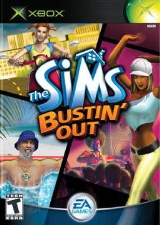
The Sims Bustin' Out
Encyclopedia
The Sims Bustin' Out is the second title in The Sims console
series. Bustin' Out was released for the PlayStation 2
, Xbox
, Nintendo GameCube
, Game Boy Advance
and N-Gage
in the fourth quarter of . As the title
suggests, the Sims can get out of the house to visit other locations such as Shiny Things Lab or Casa Caliente. There are two modes. Bust Out Mode which has mission based gameplay and Freeplay Mode which is open-ended gameplay very much like the original The Sims PC game. The PlayStation 2 version also features the option to play online, though EA no longer supports it.
The Game Boy Advance and N-Gage version puts the player's Sim in a place called "SimValley" for summer holiday. Like the console version, GBA/N-Gage version gameplay is objective-based - every time the player completes a series of tasks, the game is allowed to progress. In this game, there are no furnishing objects to unlock. Instead, the player must complete all tasks to unlock new houses.
Deviating from the "point-and-click" selection process heretofore used in every Sims title, this version allows the user to control their Sim directly, using the GBA's directional pad.
In both versions, there are various locations that Sims may visit throughout the course of the game. As Sims advance through the game, new areas become accessible. In the GBA version, new mini-games may be unlocked in certain areas. In the N-Gage version, new mini-games (jobs for the Sims) are unlocked progressively when certain tasks are done. Also, Sims can collect three cartridges from various locations and play classic games such as Snakes on the Sims' mobile phones.
Video game console
A video game console is an interactive entertainment computer or customized computer system that produces a video display signal which can be used with a display device to display a video game...
series. Bustin' Out was released for the PlayStation 2
PlayStation 2
The PlayStation 2 is a sixth-generation video game console manufactured by Sony as part of the PlayStation series. Its development was announced in March 1999 and it was first released on March 4, 2000, in Japan...
, Xbox
Xbox
The Xbox is a sixth-generation video game console manufactured by Microsoft. It was released on November 15, 2001 in North America, February 22, 2002 in Japan, and March 14, 2002 in Australia and Europe and is the predecessor to the Xbox 360. It was Microsoft's first foray into the gaming console...
, Nintendo GameCube
Nintendo GameCube
The , officially abbreviated to NGC in Japan and GCN in other regions, is a sixth generation video game console released by Nintendo on September 15, 2001 in Japan, November 18, 2001 in North America, May 3, 2002 in Europe, and May 17, 2002 in Australia...
, Game Boy Advance
Game Boy Advance
The is a 32-bit handheld video game console developed, manufactured, and marketed by Nintendo. It is the successor to the Game Boy Color. It was released in Japan on March 21, 2001; in North America on June 11, 2001; in Australia and Europe on June 22, 2001; and in the People's Republic of China...
and N-Gage
N-Gage
The N-Gage is a mobile telephone and handheld game system by Nokia, based on the Nokia Series 60 platform, released in October 2003. It began sales on October 7, 2003. The N-Gage QD replaced the original N-Gage in 2004....
in the fourth quarter of . As the title
Title
A title is a prefix or suffix added to someone's name to signify either veneration, an official position or a professional or academic qualification. In some languages, titles may even be inserted between a first and last name...
suggests, the Sims can get out of the house to visit other locations such as Shiny Things Lab or Casa Caliente. There are two modes. Bust Out Mode which has mission based gameplay and Freeplay Mode which is open-ended gameplay very much like the original The Sims PC game. The PlayStation 2 version also features the option to play online, though EA no longer supports it.
Gameplay
In the console version, Malcolm Landgraab is going around his neighborhood, stealing items in return for unpaid rent. The player's objective is to complete each career track, unlock and buy back everyone's many possessions, and become rich enough to evict Malcolm from his mansion and move their own Sim in.The Game Boy Advance and N-Gage version puts the player's Sim in a place called "SimValley" for summer holiday. Like the console version, GBA/N-Gage version gameplay is objective-based - every time the player completes a series of tasks, the game is allowed to progress. In this game, there are no furnishing objects to unlock. Instead, the player must complete all tasks to unlock new houses.
Deviating from the "point-and-click" selection process heretofore used in every Sims title, this version allows the user to control their Sim directly, using the GBA's directional pad.
In both versions, there are various locations that Sims may visit throughout the course of the game. As Sims advance through the game, new areas become accessible. In the GBA version, new mini-games may be unlocked in certain areas. In the N-Gage version, new mini-games (jobs for the Sims) are unlocked progressively when certain tasks are done. Also, Sims can collect three cartridges from various locations and play classic games such as Snakes on the Sims' mobile phones.
See also
- The Sims
- The Urbz: Sims in the CityThe Urbz: Sims in the CityThe Urbz: Sims in the City is a video game for the GameCube, PlayStation 2, and Xbox consoles, as well as the Game Boy Advance and Nintendo DS portable systems. It is the third Sims game for video game consoles and is the second Sims game not to be released on PC...
- The Sims 2

